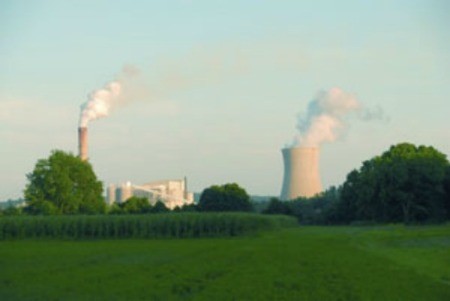
Let's face it, air pollution isn't the first thing we think of when we see plants struggling in the garden, especially for those of us living in less densely populated areas, Still, like people, plants need access to clean air in order to grow and maintain their health. Scientists have recognized that air pollution can cause damage to commercial food crops since the 1960s.
There are a host of atmospheric pollutants which can cause injuries to plants or alter their growth. Although particulate matter or atmospheric dusts can also be harmful to plants, it's the gases that cause the primary damage. Three of those that are known to cause the most damage include sulfur dioxide, ozone and peroxyacyl nitrates. Others damaging gases include nitrogen dioxide, hydrogen flouride and carbon monoxide.
Where It Comes From: Sulfur dioxide results mainly from the combustion of fossil fuels. It's prevalent around industrial facilities and found in areas where air quality is poor due to prevailing wind patterns or thermal inversion (see explanation below).
How It Damages Plants: In lower doses, sulfur dioxide interferes with a plant's metabolism, suppressing its growth and reducing yields. It may also cause leaf tissue to turn pale yellow. In higher concentrations, the plant's chlorophyll mechanism is compromised. The leaves become bleached looking, and in some cases, dry out and become papery. Grass blades may turn tan or show white streaks, and the tips of the needles of certain conifer trees turn a reddish brown color. Plants known to be particularly susceptible to sulfur dioxide injuries include apples, beans, blackberries, cabbages, peas, spinach, tulips, violets, potatoes, conifers, and turf.
Where It Comes From: Ozone originates from a layer in the atmosphere called the stratosphere. Unlike other pollutants, it is not emitted directly into the air. It's thought to be a by-product of the photochemical reactions between nitrogen oxide and several types of volatile organic compounds (VOCs). Some of the common sources include gasoline vapors, chemical solvents, combustion by-products of fuels, and consumer products.
How It Damages Plants: Ozone causes mottling and bleaching in the leaves of plants (chlorosis) similar to damage caused by sulfur dioxide. Damage is usually sustained by expanding leaves, but not very young or older leaves. It is also thought to interfere with protein synthesis and the destroy cellular membranes. Nearly all plants are susceptible to damage from ozone, but some plant varieties seem more resistant than others.
Where They Come From: Peroxyacyl nitrates form when sunlight reacts to certain compounds in car exhaust. This pollutant is most prevalent in areas where smog alerts and thermal inversions are common and large amounts of hydrocarbons are released into the air from automobiles.
How It Damages Plants: Peroxyacyl nitrate causes a disorder in plants known as "silver leaf." The youngest and most rapidly growing leaves on a plant are the most susceptible. They develop white or bronze spots on the undersides of their leaves, which turn to a silvery sheen. Plants show a general lack of vigor and produce lower than normal yields. Injuries from this pollutant look similar to (and is often mistaken for) damage from thrips, mites, or sunscald. Vulnerable plants include beans, lettuce, peppers, spinach, Swiss chard, tomatoes, dahlias, and petunias.
The extent an individual plant is injured by air pollution depends largely on the current environmental conditions, the plant's stage of development, its overall health and the concentration level of the pollutants. Some gardens, however, are more at risk than others. Regionally, pollution sources tend to be more concentrated in larger cities or in geographic areas where the natural topography prevents it from dispersion (Los Angles, Denver, and Mexico City). On a more local level, gardens located near busy highways or next to streets with a steady flow traffic are more likely to see plant injuries from car exhaust.
The two most important atmospheric conditions that affect the dispersion of air pollutants are the stability of the atmosphere (to allow dispersion of pollutants vertically), and the strength of the wind (for horizontal dispersion). In the weather phenomenon known as thermal inversion, a layer of cooler air is trapped near the ground by a layer of warmer air above.
Environmental disorders are not as easy to control as pests or plant diseases. The best way to control harmful air pollutants is to support regulations to reduce (or stop) industrial emissions. You can do your part to help reduce emissions by driving less, burning fuel more efficiently, and properly disposing of your garbage and chemical waste. Eliminating or reducing the use of fertilizers (nitrous oxide) and pesticides, especially those containing methyl bromide, will help keep ozone-attacking chemicals out of the atmosphere.Plants already under stress are more likely to succumb to injuries from air pollution. Minimize stress by keeping your plants otherwise healthy and free from pests and disease and by maintaining adequate soil moisture levels-especially during weather patterns that support increased air pollution. If possible, keep garden beds as far away from busy highways and other pollution sources as possible and talk with nurseries in your area about local plant varieties which may be more resistant to air pollution injuries.

About The Author: Ellen Brown is our Green Living and Gardening Expert. Click here to ask Ellen a question! Ellen Brown is an environmental writer and photographer and the owner of Sustainable Media, an environmental media company that specializes in helping businesses and organizations promote eco-friendly products and services. Contact her on the web at http://www.sustainable-media.com
Add your voice! Click below to comment. ThriftyFun is powered by your wisdom!